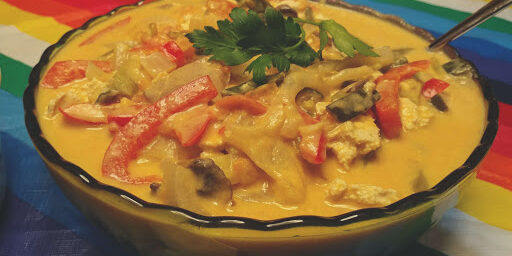The traditional Bhutanese food holds a variety of unique flavors and ingredients. Since the country is still somewhat isolated from the outside world, its cuisine has evolved from its neighbors. Unlike the more mainstream countries in Asia like Japan and China, food is eaten with your hands while sitting cross legged on the floor. However, as the country has slowly begun to modernize some families have now deemed it acceptable to sit at tables and use cutlery. It is proper etiquette in Bhutan to refuse food the first couple times it is offered while covering your mouth and saying, “Meshu, Meshu” before finally accepting the food. Women typically serve the meals and before beginning to eat a small prayer is said, followed by a small piece of food being placed on the floor as an offering to spirits. Bhutan’s meals follow the typical style in Asia which is a family style buffet where you can sample portions of everything. The cuisine in Bhutan tends to be quite spicy and contain chillies in almost every dish.

Background: Where Bhutanese Food Comes From
We can now start to dive into where Bhutanese food gets its different ingredients. Agriculture and animal husbandry hold a dominant role in Bhutan’s economy with roughly ninety five percent of the country’s population relying on it for their livelihood. Almost all working women are involved in the countries agriculture sector which has helped boost the economy in Bhutan. The majority of crops cultivated in Bhutan are Maize and Rice, with rice being the major staple crop. Agriculture in Bhutan also includes wheat and other similar crops. In the area’s that contain proper irrigation paddy is the main crop harvested. These areas also cultivate barley, oil seeds, and potato, as well as a variety of vegetables like spinach, broccoli, turnips, and carrots. Forests are responsible for managing the availability of water used for agriculture. Bhutan has focused on raising the per capita income of people that live in rural areas by increasing self-sufficiency in staple crops and increasing the productivity of farm labor on available agricultural land. Farmers often run into various problems such as; insufficient soil, rugged terrain, and limited amount of available farmable land. But multiple agricultural land development projects were successful with the help of trained agricultural experts and the use of fertilizers. In 2013 the government shared that Bhutan will be the first country on the planet with one hundred percent organic farming. This is a huge benefit for the popularity of Bhutanese food, by both residents and visitors.
The rangelands in Bhutan provide livestock which is an indispensable area of the agricultural production system for the country. The livestock provide important items like milk, butter, cheese, and meat for the numerous food dishes offered. Horses, Yaks, and mules are used for transporting goods through the mountainous country that consists of very few roads. The production of livestock in Bhutan revolves around milk because most meals contain milk products. A yak butter tea is frequently consumed as well as a side dish that is similar to cottage cheese and is mixed with chili peppers. Yaks act as a very important part of the pastoral system, specifically in the highland regions. Yak’s and their cattle are used for meat, butter, cheese, and are also traded for other goods that are harvested in Bhutan. Many of the yak herders are nomadic, having no permanent cultivated land and live in large black tents made from yak hair. They follow traditional routes moving around to numerous grazing areas. The majority of agriculture farmers in Bhutan also own cattle that provide milk products for personal consumption and use the available manure as a source of fertilizer for their crops. The Siri cattle are the most common breed owned in Bhutan. They are fairly small in size and slow to mature. In forested areas, hybrid cattle are used because they can forage better than local cattle. These cattle are a crossbreed between Minthun cattle and Siri cattle. Bhutan cattle owners constantly battle outbreaks with livestock such as internal parasites, and the most infectious disease shaemorrhagic septicaemia which is a foot and mouth disease. There is roughly one million acres of grazing land available varying from subtropical grasslands and forested areas to alpine rangelands. Fire is also commonly used to control unwanted vegetation and to expand grazing land when needed.
Book a food tour by contacting us below.





